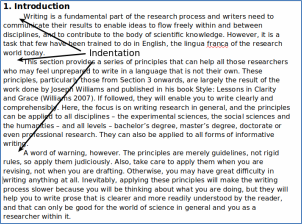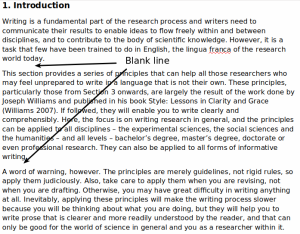Texts are conventionally divided into paragraphs. One way of marking paragraphs is to indent the first line like this.
More important than visual appearance, however, is the effect paragraphing can have on content. Paragraphs give you the opportunity to organize the information you wish to give your readers into manageable, logical units so that they can see how you develop your argument as you move from one topic to another.
Exactly what constitutes a well-written paragraph is not easy to define. Nevertheless, some features are worth mentioning: point sentences, cohesion and coherence.

Figure 1. Indenting
Another way is to leave a complete blank line between one paragraph and the next.

Figure 2. Blank lines
More important than visual appearance, however, is the effect paragraphing can have on content. Paragraphs give you the opportunity to organize the information you wish to give your readers into manageable, logical units so that they can see how you develop your argument as you move from one topic to another.
Exactly what constitutes a well-written paragraph is not easy to define. Nevertheless, some features are worth mentioning: point sentences, cohesion and coherence.
Recommended citation:
«Paragraphs» [en línia]. A: Llibre d’estil de la Universitat de Barcelona. Barcelona: Universitat de Barcelona. Serveis Lingüístics. <https://www.ub.edu/llibre-estil/criteri.php?id=3300> [consulta: 26 abril 2024].


